|
Special Features





Image Libraries


|
|
Blog
Senator Lindsey Graham (R-SC) says he will vote against the climate bill he helped to write, which dramatically reduces the likelihood that Congress will be able to pass a bill to, y’know, avert global catastrophe. Ain’t partisanship super?
In honor of Mr. Graham’s decision to give the finger to future generations, here are some images from geology.com’s sea level rise mapper. At least we’ll know who gets screwed over the most.
Climate scientists have so far pegged likely sea rise over the next century at somewhere between one and two meters. Here’s what a two meter rise would do to DC:
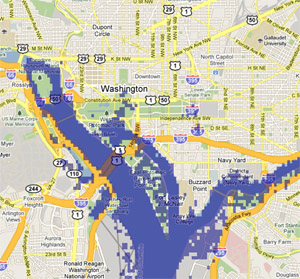
That’s not so bad. East Potomac Park is gone, some Pentagon parking lots go under, and the White House gets a reflecting pool. Hardly worth paying more for gas.
Here’s New York (left) and Ocean City (right):
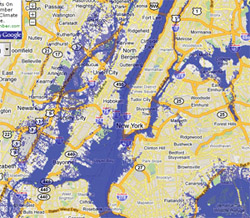 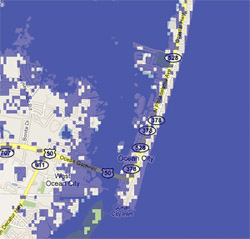
Except for some flooding around the Battery, Manhattan survives. Jersey’s Meadowlands become Meadow Bay, however, and all that’s left of Ocean City is Coastal Highway. Totally the best part.
Now New Orleans and The Netherlands:
 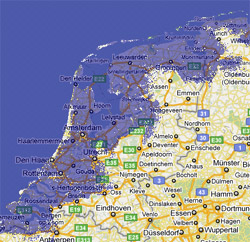
Well, nobody likes them anyway.
But hey, that 2-meters-in-a-century assumption is based on the slow gradual model of climate change. If something big happens, like say the Greenland ice sheet melts, we’re looking at more like a 7 meter rise. Here’s what that does to DC:
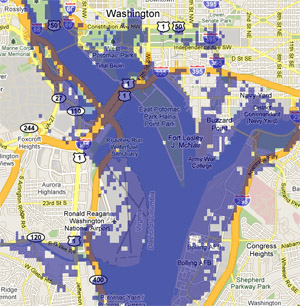
Goodbye, Southwest. Maybe we’ll get a water polo team to play in the Nationals stadium.
New York and Florida:
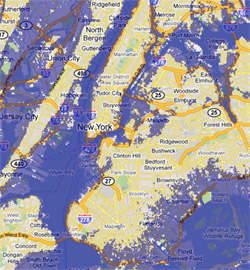 
Manhattan loses a few blocks on either side, but the outer boroughs really suffer. Fort Myers and Naples are gone, but it’s kind of cool that Lake Okeechobee is a bay.
Hopefully you don’t know any of the 40 million people who call the Nile Delta home:
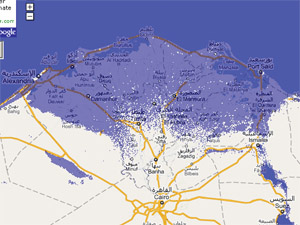
But you know, that’s awfully unrealistic. 7 meters from Greenland? Come on. Everybody knows that if Greenland goes, there’s a good chance West Antarctica could go too. That’s more like 12 meters. Here’s 12 meters of new Potomac:
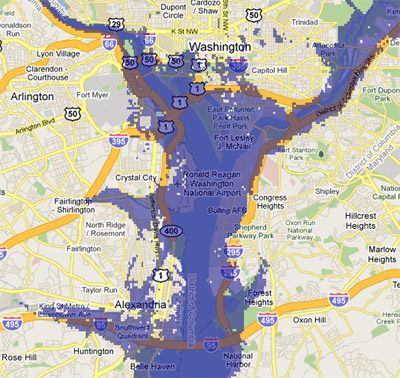
:shrug: Sorry, Alexandria.
New York and Northern California:
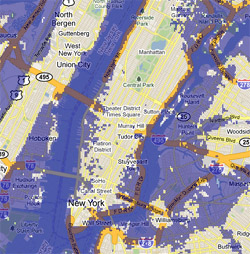 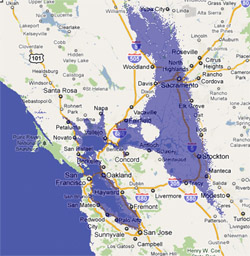
Manhattan’s rapidly losing ground now, and Brooklyn is about as big as Manhattan used to be. Most of the City of San Francisco survives, but all its suburbs are gone and Sacramento is at the bottom of a new sea.
Hope nobody is too attached to central London:
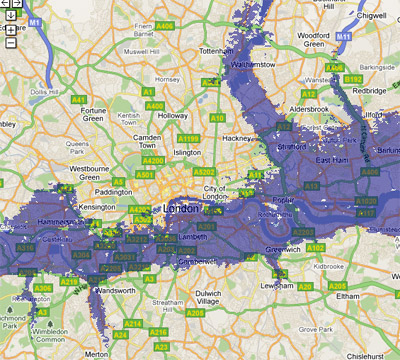
And you know what, if you’re one of the 160 million people in Bangladesh then you have only yourself to blame:
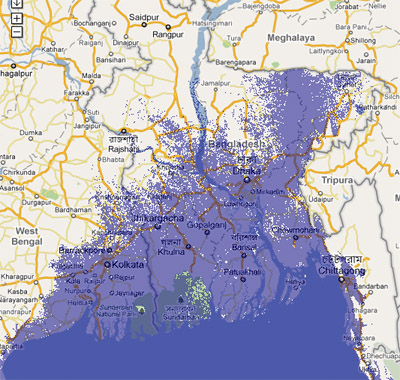
You can recreate all these maps at geology.com. It’s fun! Sort of like disaster mode on SimCity, except it’s the real world!
* Note that if this happens, Denver will be a desert. You wouldn’t want to live there either.
Average Rating: 4.5 out of 5 based on 268 user reviews.
June 8th, 2010 | Permalink
Tags: environment, featured post

I assume this is a real picture. It came to me as a lulzy email.
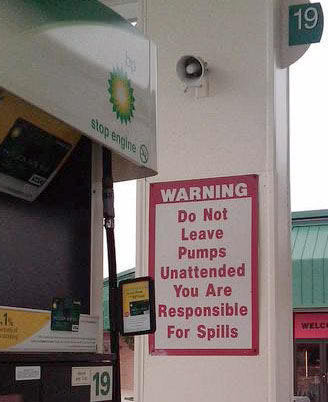
Average Rating: 5 out of 5 based on 192 user reviews.
June 8th, 2010 | Permalink
Tags: environment, fun

Earlier this week the US Green Building Council officially launched LEED-ND, environmentally friendly standards for neighborhood development. I discuss the launch, and how it could revolutionize Smart Growth, on the Washington Post Local Blogging Network.
Average Rating: 4.9 out of 5 based on 151 user reviews.
April 30th, 2010 | Permalink
Tags: environment, urbandesign, washpostblog

Yesterday President Obama announced that the Atlantic east coast will be opened for oil drilling. Republicans love him for it, environmentalists are aghast.
The big problem with drill baby drill was never so much the drilling itself, it was the misguided political opinion among proponents that drilling for more oil would solve all our problems forever. That if only we could find another oil field nearby we could go back to the good ole days and never have to worry about expensive energy again. That’s what happened after the Alaska and North Sea oil fields ended the 1970s crisis. With the gas flowing again, all the green initiatives started by Jimmy Carter were laughed out of the room. Then 20 years later those fields ran dry, we hit another spike in prices, and instead of being prepared with 20 years worth of research into alternates, we were right back where we started.
Obama, by continuing to enhance his green agenda, offers a key contrast. Rather than “drill to save us”, his position seems to be “develop alternates for the long term, but drill in the interim if we have to”. Such a politically practical position may not be ideologically pure, but it probably increases Obama’s chances of being taken seriously by moderates and right-leaners (if not crazies), and thus increases his chances of broader success in the green movement. We will need moderate support to pass serious environmental reform, after all. And while the Green Party is ideologically pure, they haven’t passed much legislation.
So while the danger is that someone will come along and say drilling is all we need to do, the benefit is that with a Democrat who knows better in office we can continue all the good stuff, and hopefully find supporters for more.
I’d prefer we not drill, but if drilling buys us a better long term deal, then I can live with it.
Average Rating: 4.4 out of 5 based on 275 user reviews.
April 1st, 2010 | Permalink
Tags: environment, government

|

The face of evil, according to some people in Gaithersburg.
Photo by flickr user Baying Hound. |
Urban chickens are really, really great. They’re an essentially free, organic, and local source of food, fertilizer, and pest control. They eat cockroaches and mosquitos and in return give you an unending supply of eggs. It used to be everybody with a backyard kept a backyard chicken coop, and as word of their benefits gets around again, more and more people are starting up the old practice. It’s one of the best and easiest ways to go green.
Except, y’know, a lot of people think backyards should be reserved for perfectly manicured Kentucky Bluegrass and that actual nature, agriculture, or production shouldn’t come within several miles of their subdivision, for fear of what it might do to their property values.
More and more people in Gaithersburg are keeping backyard chickens, and as a result an increasing number of people are demanding the city put a stop to it. The city – Montgomery County’s long-time agricultural center – is officially considering a ban and will take up the issue at a public hearing on Monday.
Gaithersburg has the option of going green, or going NIMBY. Let’s hope they make the right decision.
 Cross-posted at Greater Greater Washington. Cross-posted at Greater Greater Washington.
Average Rating: 5 out of 5 based on 298 user reviews.
March 19th, 2010 | Permalink
Tags: environment, government

|

Cell phone picture of a DC snowpile, taken 3 or 4 days after snowpocalypse. |
Would you take a bite out of the snow pile pictured at right?
Of course you wouldn’t; that’s disgusting. Seriously, gross. You’ve done it, though. You do it all the time.
The pollution that makes snow so ugly after a few days on the street doesn’t magically appear whenever it snows. It’s always there, produced by our litany of motorized vehicles. It floats around the air we breathe for a while before settling on the ground, or in the water. Every time you walk behind a truck or big SUV and get a whiff of exhaust, you’re essentially taking a big bite out of a delicious soot-flavored snowcone.
But that’s just the cost of doing business in a modern civilization… right?
Average Rating: 4.5 out of 5 based on 255 user reviews.
March 1st, 2010 | Permalink
Tags: environment

It’s not that people want parks; it’s that they don’t want anything.
|
|
Matt Yglesias sparked a debate about parks with his post How Many Parks Do You Need?, in which he questioned the wisdom of turning every available plot of land into a park rather than developing the land with productive buildings. Richard Layman chimed in with a typically verbose explanation.
The Yglesias and Layman posts are both good reads, but they’re both overthinking the issue. It’s not that people want parks; it’s that they don’t want anything. The average American has become so disillusioned with the typical way we build cities (that is, suburbs) that not building anything has become the default best use of land in the minds of almost everybody. In the minds of the parks-everywhere crowd “greenspace” is code for “no more traffic”.
Consider this case from Fairfax. Residents agreed to create a new tax specifically for the city to purchase new park land. When the city did so and came out with a design for a new park, residents went full NIMBY. They opposed the new park, because it had fields and playgrounds that might induce people to drive there. No, what Fairfaxians wanted was for the city to buy up as much as it could and leave it empty. They didn’t want parks, they wanted a shield from development. Similar cases abound across the country.
Of course, the sort of urban thinkers likely to read this blog know that spreading development out is utterly counterproductive, because development has to go somewhere and less here means more further down the road, which in turn means more congestion for everybody. But a lot of Americans don’t get that yet, and still think that development = cars. Until that paradigm changes, there will always be people clamoring for as much of nothing as they can get.
Average Rating: 4.6 out of 5 based on 163 user reviews.
August 17th, 2009 | Permalink
Tags: development, environment

“The word in Washington is that the administration believes it has enough on its plate with health care, climate change, and other daunting issues, and that it doesn’t have an appetite at this point for a knock-down, drag-out battle over long-term transportation funding.”
– Finance and Commerce newspaper on the fight between President Obama and Congressman Oberstar regarding the timing of the Transportation spending authorization bill.
Dear President Obama,
You cannot address climate change without addressing transportation.
Hugs and kisses,
BeyondDC
Average Rating: 4.8 out of 5 based on 188 user reviews.
August 6th, 2009 | Permalink
Tags: environment, government, people, transportation

Just in case you don’t get enough micro-blogging via twitter…
- The Transportation Planning Board will vote today on inclusion of the Purple Line as light rail on the Georgetown Branch right-of-way in the air quality analysis of the regional transportation plan. Chevy Chase NIMBYs are sure to show up and make further impassioned arguments such as think of the children (but not all of them). Personally, I’m done taking Purple Line opponents seriously.
- Speaking of the TPB, their task force working on a regional bus priority stimulus application is meeting today and will be deciding exactly what to include in its application over the next two weeks. BeyondDC will report as appropriate. Fair warning: The final application is going to look a lot different than that first-draft map at GGW.
- TysonsTunnel, the group hoping to build a subway in Tysons Corner rather than an el, is suing. The ship has sailed guys, changing course now would seriously harm the project. What are you really trying to accomplish?
- In case you haven’t heard, Congressman Oberstar is expected to release his outline of the next TEA bill on
Wednesday Thursday. T4America will have plenty of coverage, and I’m sure I’ll have something to say about it as well.
- No, we do not need to widen I-270. All those past widenings worked oh-so-well.
- Ryan Avent notes that the DC metro area is still outperforming most of the country in housing construction. Also, reports yesterday show that housing starts are up nationally.
- You know how Virginia has been totally unable to pass meaningful and constitutionally legal transportation funding legislation? Maybe the problem is systemic. Virginia is the dead last state to send in its transportation stimulus requests.
- Global climate change is here, and it’s real. Let’s not pretend otherwise.
Average Rating: 4.6 out of 5 based on 175 user reviews.
June 17th, 2009 | Permalink
Tags: economy, environment, government, transportation

On Friday Ryan Avent mentioned electrification of freight railroads as a way to synergistically support cleaner energy and high speed passenger rail. Interesting idea, but why end there?
I wonder how much of our pollution problem could be solved by taking the technology of overhead wires, or catenary, to the next level and installing it not only where we want to run trains, but anywhere with a high volume of road traffic. Some cities already use trolley buses, but if you’re going to put in wires anyway, why limit access to only buses? Why not trucks? Why not regular autos?
Catenary is expensive, so it’s probably impractical to put it on every street, but aside from aesthetics, why shouldn’t we put it on the big ones? Why not build hybrid cars with gas motors and trolley pole connections that can hook up to an overhead wire whenever they come across a major arterial or highway?
Average Rating: 4.9 out of 5 based on 276 user reviews.
June 15th, 2009 | Permalink
Tags: environment, transportation

|
Media





Site
About BeyondDC
Archive 2003-06
Contact
Category Tags:
Partners
|































